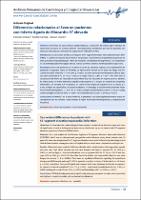Diferencias relacionadas al Sexo en pacientes con Infarto Agudo de Miocardio ST elevado
Related Resource(s)
https://apcyccv.org.pe/index.php/apccc/article/view/10Date
2020-05-04Author(s)
Chávez, Francisco
Espinola, Sandra
Chacón, Manuel
Metadata
Show full item recordAlternate title
Sex-related differences in patients with
ST-segment elevation myocardial infarction
Abstract
Objetivo: Determinar las características epidemiológicas, localización del infarto, tipo y tiempos de reperfusión, así como los eventos adversos intrahospitalarios, distribuidos por sexo en pacientes con infarto de miocardio con elevación del segmento ST (IAMCEST) en Perú.
Métodos: Es un sub-análisis del PEruvian Registry of ST-segment Elevation Myocardial Infarction (PERSTEMI), el cual fue un estudio observacional, prospectivo y multicéntrico de pacientes mayores de 18 años que fueron hospitalizados por infarto de miocardio con elevación del segmento ST. Se compararon las características epidemiológicas, clínicas, manejo y eventos adversos intrahospitalarios según sexo.
Resultados: De los 396 pacientes, se encontró un 20.9% de pacientes mujeres, con un predominio de población octogenaria sobre los hombres. La hipertensión arterial fue el factor de riesgo más frecuente en el sexo femenino (74.7 Vs. 50%, p = 0.001); así como como las manifestaciones clínicas atípicas como disnea (40.9 Vs. 27.1%, p = 0.012) y síncope (10.8 vs. 3.8%, p = 0.017). Por otro lado, la localización del infarto de miocardio en cara inferior fue más frecuente en mujeres (51.8 vs. 38.98%). En ambos sexos, no hubo diferencias significativas respecto a la terapia de reperfusión empleada (Fibrinólisis, ICP primaria, ICP en general); así como en los tiempos de isquemia (6 vs. 5.6 horas, p = 0.456), tiempos de reperfusión y estancia hospitalaria. Sin embargo, el sexo femenino presentó mayor mortalidad intrahospitalaria (21.6 vs. 7%, p = 0.001), complicaciones mecánicas (8.4 vs. 1.9%, p = 0.008), shock cardiogénico (15.6 vs. 9.5%, p = 0.087) e insuficiencia cardiaca (33.7 vs 24.9%, p = 0.072).
Conclusiones: El IAMCEST en el sexo femenino se presenta a una edad significativamente mayor en comparación con los varones y está asociado a mayor mortalidad intrahospitalaria y complicaciones mecánicas. Objective: To determine the epidemiological characteristics, location of the infarction, type and times
of reperfusion, as well as in-hospital adverse events, distributed by sex in patients with ST-segment
elevation myocardial infarction (STEMI) in Peru.
Methods: It is a sub-analysis of the PEruvian Registry of ST-segment Elevation Myocardial Infarction
(PERSTEMI), which was an observational, prospective and multicenter study about patients over 18
years-old, who were hospitalized for ST-segment elevation myocardial infarction. Epidemiological and
clinical characteristics, management and in-hospital adverse events were compared according to sex.
Results: 396 patients were studied, 20.9% were female, with a predominance of octogenarian population over men. High blood pressure was the most frequent risk factor in women (74.7 Vs. 50%, p =
0.001); as well as atypical clinical manifestations such as dyspnea (40.9 Vs. 27.1%, p = 0.012) and syncope (10.8 vs. 3.8%, p = 0.017). On the other hand, the inferior wall myocardial infarction was more
frequent in women (51.8 vs. 38.98%). There were no significant differences regarding the reperfusion
therapy used (Fibrinolysis, primary PCI, PCI in general); as well as in times of ischemia (6 vs. 5.6 hours,
p = 0.456), reperfusion times and hospital stay between both sexes. However, the female sex presented higher in-hospital mortality (21.6 vs. 7%, p = 0.001), mechanical complications (8.4 vs. 1.9%, p =
0.008), cardiogenic shock (15.6 vs. 9.5%, p= 0.087) and heart failure (33.7 vs. 24.9%, p = 0.072).
Conclusions: STEMI in females presents at significantly older age compared to males and is associated
with higher in-hospital mortality and mechanical complications.
Collections
- Artículos científicos [890]






